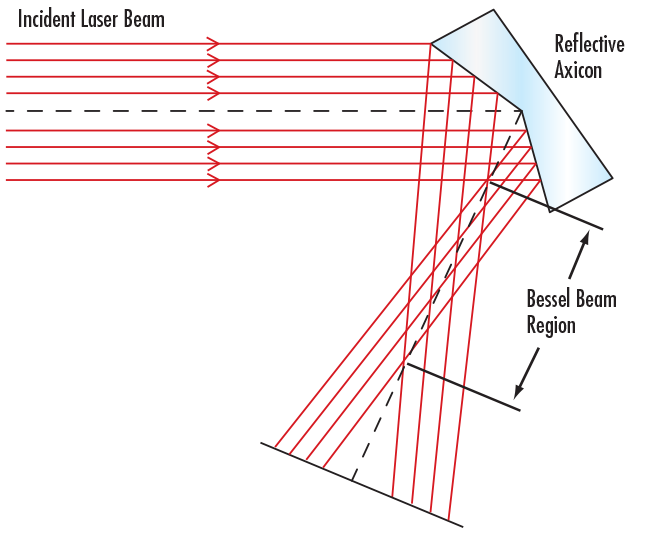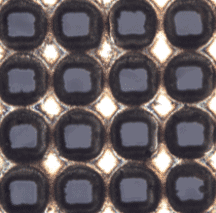
|
|
Reflective axicons generate high quality Bessel beams with optimal depth of field. |
|
|
Free from chromatic aberration, which preserves the pulse duration of ultrafast lasers. |
|
|
Low-loss beam shaping utilizes reflective Multi-Plane Light Conversion (MPLC). |
|
|
Ideal for laser material processing, medical applications, and additive manufacturing. |
Shaping laser beams with a Gaussian profile into flat top or Bessel beams is critical for many precise laser applications. While refractive beam shaping optics are commonly used, reflective beam shapers and axicons eliminate transmission losses and can handle higher power lasers. They also eliminate chromatic dispersion, making them ideal for ultrafast systems. Reflective beam shapers are ideal for micro-materials processing and other highly-precise laser applications. Advances in ultrafast lasers and other laser technology have led to an increasing number of systems utilizing beam shapers to improve efficiency and precision.
Transmissive axicons are conical optics that transform incident collimated light into a ring-shaped beam profile in the far field and approximate a Bessel beam over a given region in the near field. In the Bessel beam region, the beam does not diffract and expand as it propagates, as shown later in Figure 2. In fact, the width of the Bessel beam may be smaller than the diffraction limit.
Off-axis reflective axicons generate high-quality, Bessel beams that offer several benefits over transmissive axicons. Reflective axicons create closer-to-ideal Bessel beams than transmissive designs and are more resistant to high power lasers. The lack of propagation through an optical medium also eliminates chromatic dispersion, which maintains pulse duration in ultrafast laser applications. Figure 1 shows a typical schematic for generating a Bessel beam with a reflective axicon.

Figure 1: This off-axis reflective axicon closely approximates a Bessel beam over a given region and then continues to propagate in a ring-shaped distribution.
The intense concentration of light in Bessel beams generated by reflective axicons is ideal for laser materials processing, such as nano-channel drilling in glass and other transparent materials.1 Glass cutting efficiency can be maximized by first drilling nano-channels and then applying a force to fracture the glass along the holes. The dimensions of the holes can be finely controlled with high reproducibility. To learn more about axicons, visit our An In-Depth Look at Axicons application note.

Figure 2: The intensity distribution of a Bessel beam formed with a reflective axicon (above) and a nano-channel drilled into glass using a Bessel beam (bottom), courtesy of Cailabs2.
Multi-plane light conversion (MPLC) is a low-loss beam shaping process that involves phase plates and free space propagation.3 MPLC is ideal for multiple-beam systems, as the beams can be shaped simultaneously. MPLC can be done in both transmissive and reflective configurations, and reflective MPLC systems avoid the dispersion and absorption resulting from propagating through refractive optics. This technique was developed by Cailabs, a French deep technology company based in Rennes.
Reflective beam shapers utilizing MPLC are often configured as multi-pass cavities, in which incident laser beams are reflected many times between a reflective phase plate and a mirror to produce the desired output beam profile. These systems benefit from high mode selectivity and low insertion loss. Watch the video below for more information on MPLC.
Overview of MPLC, courtesy of Cailabs
Generating flat top beams using MPLC can increase precision and improve the efficiency of laser applications such as micro-materials processing. Flat top beams improve processing quality by reducing thermal effects along the sides of features, enabling flat edges. The transverse beam shape can also be tailored to a square shape, which minimizes side overlap and material waste (Figure 3).4 MPLC systems can accept many different laser modes and can be tailored to reject unwanted modes, making them less sensitive to imperfect input beams and beam variation over time. Additional benefits of reflective beam shaping include compatibility with galvo scanners, higher manufacturing yields, shorter processing times, and no chromatic dispersion in femtosecond regime. Reflective beam shaping using MPLC also improves accuracy in laser welding, marking, surface texturing, and additive manufacturing.

Figure 3: These square features were micro-drilled with a CANUNDA-PULSE reflective laser beam shaper with an Amplitude Ultrafast Laser, and their shape minimizes side overlap and material waste. Image courtesy of Cailabs.
Edmund Optics’ (EO) reflective Canunda-Axicons offer high-quality Bessel beam formation and can handle both high power and short ultrafast pulses. Canunda-Axicons form Bessel beams without oscillations in the intensity distribution that are closer to a theoretical profile than those formed by refractive axicons. The reflective design and precise apex manufacturing also eliminate chromatic dispersion, making them ideal for ultrafast lasers.
 Why is chromatic dispersion important for ultrafast laser systems?
Why is chromatic dispersion important for ultrafast laser systems?
 What is the peak energy that reflective Canunda-Axicons can handle?
What is the peak energy that reflective Canunda-Axicons can handle?
The Canunda-Axicons are well-suited to operate with high-energy lasers up to 1mJ, even in the femtosecond regime, thanks to their low-loss coating and reflective design.
 Is Multi-Plane Light Conversion (MPLC) used for applications other than materials processing?
Is Multi-Plane Light Conversion (MPLC) used for applications other than materials processing?
Yes, MPLC, developed by Cailabs, is also useful for optical fiber communication. It can increase bandwidth in multimode fiber systems without greatly increasing system complexity and cost. It can also be used for optical communication, such as ground to satellite, by filtering atmospheric turbulences and combining lasers while maintaining a low divergence.
 At what pulse duration is a laser considered to be “ultrafast?”
At what pulse duration is a laser considered to be “ultrafast?”
or view regional numbers
QUOTE TOOL
enter stock numbers to begin
Copyright 2023 | Edmund Optics, Ltd Unit 1, Opus Avenue, Nether Poppleton, York, YO26 6BL, UK
California Consumer Privacy Acts (CCPA): Do Not Sell or Share My Personal Information
California Transparency in Supply Chains Act
The FUTURE Depends On Optics®